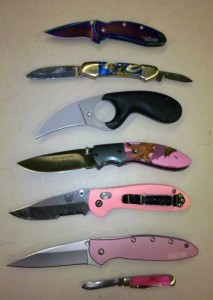Both revolvers and semi-automatic firearms fire only one shot each time the trigger is pressed. Neither type is a “machine gun,” and neither allows the shooter to fire more than one shot with each press of the trigger.
Neither one really allows the shooter to shoot much faster than the other, although there are some speed differences that world-class shooters such as Jerry Miculek or Rob Leatham would notice. Most casual shooters, even people who are trying to go very fast, will never be able to shoot either type of gun fast enough to notice any speed difference in the mechanics between the two types. 1
Note: There are some technical terms below. To avoid confusing anyone, I tried to keep things as simple as possible and define unusual words in the body of the text. In case that didn’t work and you get stuck, please use the glossary in the sidebar to your left.
Semi-automatic firearms are sometimes called “auto-loading” firearms. In these guns, after a round is fired, the mechanism uses leftover energy from the ammunition to remove and eject the empty case. Then it uses the energy from a coiled spring (spring tension) to bring a fresh round into the chamber and reload the gun.
When the shooter presses the trigger, the same gases from burning powder that drive the bullet forward also drive the slide to the rear. As the slide moves back, it removes the empty case from the chamber and kicks it out of the way. The slide moves forward again driven by spring tension. As it comes forward, it picks up a fresh round and stuffs it into the chamber so the gun is ready to fire again.
This means the gun automatically reloads each round for the shooter. That’s the “auto” part of semi-auto and autoloader.
This type of gun will not continue firing even if the shooter keeps her finger on the trigger. It will only load one round each time and will not fire again unless the shooter mechanically resets the action by pressing the trigger again. That’s the “semi” part of semi-auto.
When all rounds have been fired, the shooter removes the empty magazine from the gun and replaces it. This reload can be done very quickly, as long as the replacement magazine has already been filled with fresh ammunition. If the magazine has not been prepped ahead of time by being filled with new rounds, reloading a semi-auto can be very slow. Many people find refilling the magazine difficult and hard on their thumbs.
Revolvers work in a more manual way. The shooter must remove the empty cases herself and it is her own energy (not energy from the ammunition or a coiled spring) that the gun uses to bring each round into firing position.
After each round is fired and the bullet goes downrange, the empty case that used to hold the bullet stays inside the chamber. It does not go anywhere on its own. To get that empty case out of the way and to bring the next round into a position where it can be fired, the shooter must cock the revolver’s hammer. Cocking the hammer revolves the cylinder, moving the spent chamber out of the way and bringing the next chamber into line with the barrel.
To cock the hammer, the shooter either presses the trigger (“double action”) or uses her thumb to pull the hammer back (“single action”). Not all revolvers allow both of these options. Some allow only one or the other. When the hammer is completely cocked, the gun is ready to fire and any additional pressure on the trigger will make it fire. When using double action mode, the revolver shooter simply presses the trigger completely each time to make the gun fire — just as the semi-auto shooter does. 2
When all rounds have been fired, the shooter must take the empty cases out of the gun before she can reload. She does this by opening the cylinder and dumping the empties out onto the ground.
To reload, most modern revolver shooters use a “speed loader,” a device that allows a skilled revolver shooter to reload very quickly. 3
Without a speed loader, reloading the revolver must be done one round at a time, but it still takes less effort and usually less time than refilling a magazine by hand.
Notes:
- Although many of us will notice a difference in trigger pull weight, and some will shoot slower with a heavier trigger. ↩
- This is one reason that good firearm instructors teach people to always use their revolvers in double action mode for self-defense. ↩
- The link goes to a world record revolver reload. Most shooters cannot shoot or reload anywhere near that fast, with either semi-auto or revolver. ↩






